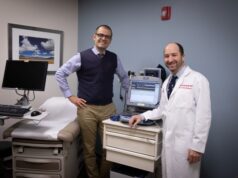
The Emblem subcutaneous implantable defibrillator system (S-ICD; Boston Scientific) demonstrated a high conversion efficacy and low adverse event rate. Data from the UNTOUCHED trial on the first 30 days after implantation of the device were simultaneously released at a late-breaking trial session at the Heart Rhythm Society’s 40th Annual Scientific Sessions (HRS 2019; 8–11 May, San Francisco, USA) and published in Heart Rhythm Journal.
In the UNTOUCHED study, the Emblem S-ICD system was used for the primary prevention of sudden cardiac death in patients with a left ventricular ejection fraction (LVEF) ≤35%—the most common population to be indicated for ICD therapy.
Principal investigator Lucas VA Boersma (St. Antonius Hospital Nieuwegein, and Amsterdam University Medical Center, Amsterdam, The Netherlands) outlined acute findings from the UNTOUCHED study—Understanding outcomes with the S-ICD in primary prevention patients with low ejection fraction. It is a global, prospective, non-randomised study at 110 sites that evaluated 1,116 patients with a low left ventricular ejection fraction (LVEF), the majority of whom (54%) had ischaemic heart disease.
Patients included were those with a primary prevention indication for sudden cardiac death (SCD) and LVEF ≤ 35%, and who had passed a screening vector test. Exclusion criteria were prior documented sustained ventricular tachycardia (VT) and/or ventricular fibrillation (VF), pacing indication, end-stage heart failure and/or renal failure, or medical status precluding device programming of conditional/shock zones at 200/250 beats per minute (bpm).
The enrolment period was from June 2015 to April 2018, and the data presented were an analysis of the characterisation of the cohort, as well as the acute outcomes of the implant procedure, conversion efficacy, and 30-day complications for 1103 participants, following withdrawal of 13 subjects.
UNTOUCHED showed that the S-ICD therapy had a 95.8% complication-free rate at 30 days post-procedure, and a 99.2% conversion efficacy of induced ventricular fibrillation. Boersma described the rates as comparable to those seen in previous S-ICD and transvenous implantable cardioverter-defibrillator (TV-ICD) studies, and said: “Most complications occurred either during the procedure or in the first 24 hours. There were consistently low complication rates across subgroups and very low severe infection rate, with no specific patient characteristic predicting complications, while the high conversion success was achieved with very few repositioning manoeuvres required.”
Investigators also looked at procedure techniques and found that the majority (69%) were performed using a two-incision technique. The two-incision technique required a mean implant time of 55.8 minutes, eight minutes faster than the mean 63.8 minutes for procedures using a three-incision implant technique, with comparable complication and conversion success rates.
Boersma pointed out that “patient characteristics were very similar between implant techniques. Only minor differences were seen in gender, race, and BMI, and there was no difference between Europe and North America.”
Investigators also noted that a higher body mass index (BMI) prolongs the procedure and may be a predictor of VT/VF conversion failure, warranting more careful attention to be paid to the implant technique and defibrillation testing in order to assure successful conversion.
Boersma said: “We found that the complication rate within this primary prevention population was as low as in prior S-ICD registries, despite the patients being older, having much lower LVEF, and more hypertension and diabetes, underscoring that sicker patients appear to do well with this device for the prevention of sudden death. These acute outcomes also validate the advantages of the two-incision implant technique, which has continued to gain worldwide adoption in the last few years.”
Follow-up continues up to 18 months, and will include an analysis comparing the primary endpoint of the trial, inappropriate shock rates of the S-ICD, to those found in previous TV-ICD studies such as MADIT-RIT.












